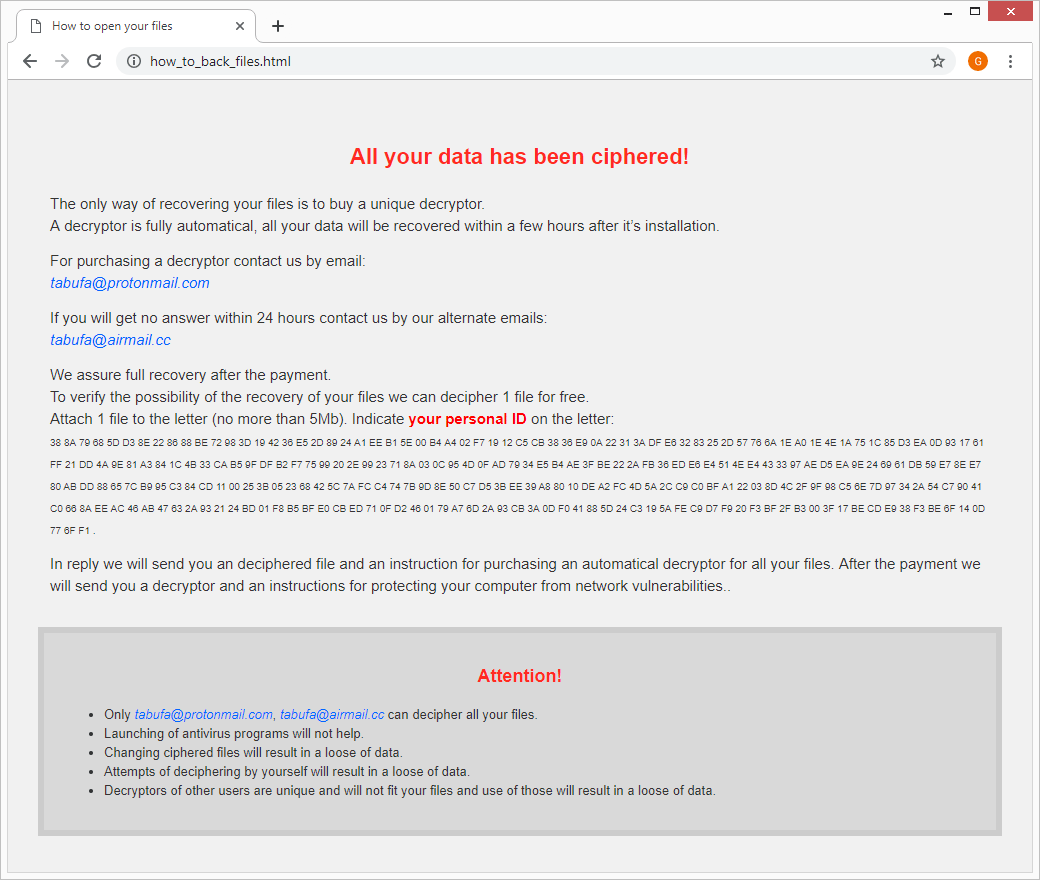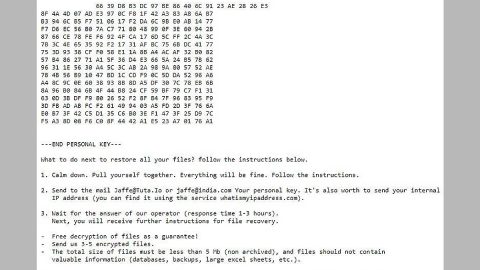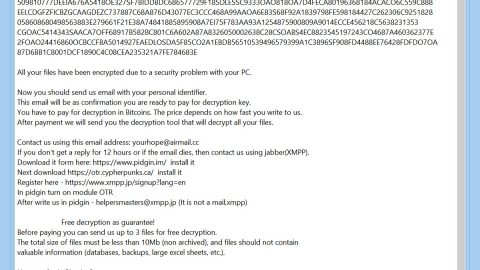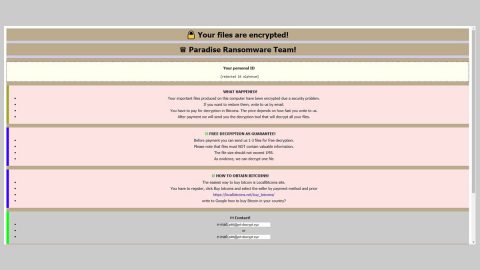What is Tabufa ransomware? And how does it carry out its attack?
Tabufa ransomware is a data-encrypting malware created to lock important files in an infected computer. This newly discovered crypto-malware belongs to the GlobeImposter 2.0 ransomware family which means that it contains similar code snippets from the infamous ransomware group so it is possible that the sample has been bought from the dark web or it could also be a customized version of a ransomware threat.

Once it infects a computer, it drops its malicious payload and executes it. The malicious payload then connects the infected computer to a remote Command and Control server controlled by the attackers. From this remote server, Tabufa ransomware downloads other malicious components and places them in several system folders. After that, it modifies the Windows Registry in order to achieve persistence and to launch or repress processes in the Windows environment.
These registry entries are usually designed in a way to start the crypto-malware automatically on every system boot. Once all the modifications in the system are carried out, it then begins the encryption process using sophisticated cryptography. After the encryption is completed it appends the .tabufa extension in every encrypted file. Following data encryption, it releases an HTML file named “how_to_back_files.html” which contains the following ransom note:
“All your data has been ciphered!
The only way of recovering your files is to buy a unique decryptor.
A decryptor is fully automatic, all your data will be recovered within a few hours after its installation.
For purchasing a decryptor contact us by email:
[email protected]
If you will get no answer within 24 hours contact us by our alternate emails:
[email protected]
We assure full recovery after the payment.
To verify the possibility of the recovery of your files we can decipher 1 file for free.
Attach 1 file to the letter (no more than 5Mb). Indicate your personal ID on the letter:
In reply, we will send you a deciphered file and an instruction for purchasing an automatic decryptor for all your files. After the payment, we will send you a decryptor and instructions for protecting your computer from network vulnerabilities…
<…>”
How does Tabufa ransomware spread online?
Tabufa ransomware may spread using several tactics. For one, it may use malicious spam email campaigns which contain infected attachments. Aside from that, it could also break through unprotected RDP configuration and install Tabufa ransomware directly in the system. In addition, crooks could also spread this crypto-malware using fraudulent downloads, exploit kits, fake software, and fake software updates. This is why you need to keep both your system and antivirus programs updated in order to keep your computer safe from this kind of cyber threat.
Eliminate Tabufa ransomware from your compromised computer with the help of the removal guide laid out below.
Step_1: The first thing you need to do is to obliterate the process of Tabufa ransomware by opening the Task Manager – simply tap the Ctrl + Shift + Esc keys on your keyboard.
Step_2: After that, switch to the Processes tab and look for any suspicious-looking process that takes up most of your CPU’s resources and is most likely related to Tabufa ransomware and then end them all.
Step_3: Now that the malicious processes are eliminated, close the Task Manager.
Step_4: Next, tap Win + R, type in appwiz.cpl and click OK or tap Enter to open Control Panel’s list of installed programs.
Step_5: Under the list of installed programs, look for Tabufa ransomware or anything similar and then uninstall it.
Step_6: Then close Control Panel and tap Win + E keys to launch File Explorer.
Step_7: Navigate to the following locations below and look for the malicious components of Tabufa ransomware like the file named how_to_back_files.html and an executable file that could be named randomly ([random].exe), as well as other suspicious files it has created and downloaded into the system and then delete all of them.
- %LOCALAPPDATA%
- %APPDATA%
- %TEMP%
- %WINDIR%\System32\Tasks
- %APPDATA%\Microsoft\Windows\Templates\
- %USERPROFILE%\Downloads
- %USERPROFILE%\Desktop
Step_8: Close the File Explorer.
Before you go on any further, make sure that you are tech-savvy enough to the point where you know exactly how to use and navigate your computer’s Registry. Keep in mind that any changes you make will highly impact your computer. To save you the trouble and time, you can just use Restoro this system tool is proven to be safe and excellent enough that hackers won’t be able to hack into it. But if you can manage Windows Registry well, then by all means go on to the next steps.
Step_9: Tap Win + R to open Run and then type in Regedit in the field and tap enter to pull up Windows Registry.
Step_10: Navigate to the following path:
- HKEY_LOCAL_MACHINE\Software\Microsoft\Windows\CurrentVersion\Run
- HKEY_CURRENT_USER\Software\Microsoft\Windows\CurrentVersion\Run
- HKEY_LOCAL_MACHINE\Software\Microsoft\Windows\CurrentVersion\RunOnce
- HKEY_CURRENT_USER\Software\Microsoft\Windows\CurrentVersion\RunOnce
Step_11: Delete the registry keys and sub-keys created by Tabufa ransomware.
Step_12. Close the Registry Editor and empty the Recycle Bin.
Try to recover your encrypted files using the Shadow Volume copies
Restoring your encrypted files using Windows Previous Versions feature will only be effective if Tabufa ransomware hasn’t deleted the shadow copies of your files. But still, this is one of the best and free methods there is, so it’s definitely worth a shot.
To restore the encrypted file, right-click on it and select Properties, a new window will pop up, then proceed to Previous Versions. It will load the file’s previous version before it was modified. After it loads, select any of the previous versions displayed on the list like the one in the illustration below. And then click the Restore button.
Congratulations, you have just removed Tabufa Ransomware in Windows 10 all by yourself. If you would like to read more helpful articles and tips about various software and hardware visit fixmypcfree.com daily.
Now that’s how you remove Tabufa Ransomware in Windows 10 on a computer. On the other hand, if your computer is going through some system-related issues that have to get fixed, there is a one-click solution known as Restoro you could check out to resolve them.
This program is a useful tool that could repair corrupted registries and optimize your PC’s overall performance. Aside from that, it also cleans out your computer for any junk or corrupted files that help you eliminate any unwanted files from your system. This is basically a solution that’s within your grasp with just a click. It’s easy to use as it is user-friendly. For a complete set of instructions in downloading and using it, refer to the steps below
Perform a full system scan using Restoro. To do so, follow the instructions below.













